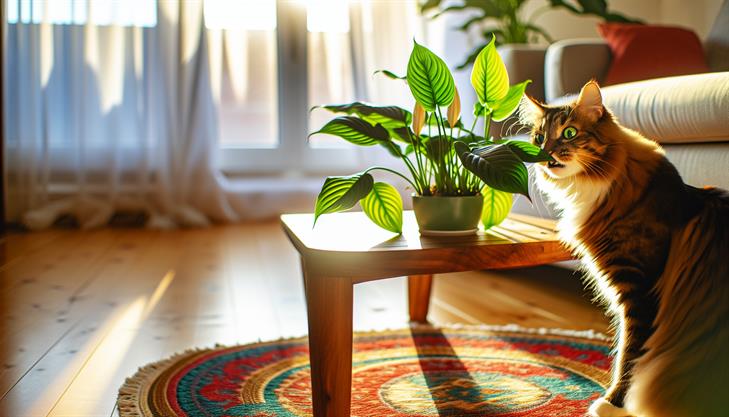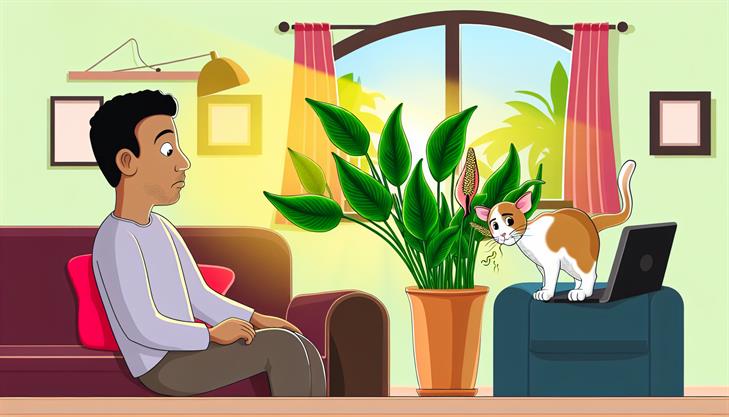If you’re a cat parent with a green thumb, you may find yourself constantly juggling the challenge of creating a beautiful indoor garden while ensuring a safe haven for your furry friends. Among the lush foliage options, the peace lily stands out as a classic choice with its striking appearance and air-purifying benefits. But, before you bring this charming plant into your home, it’s crucial to consider an important question: Are peace lilies toxic to cats? The answer could have significant implications for your feline’s health and safety. In this comprehensive guide, we’ll delve into the potential risks associated with peace lilies and provide practical tips to keep your beloved pets safe without sacrificing your home’s aesthetic appeal. Whether you’re a seasoned plant enthusiast or a new cat owner, understanding the dynamics between these plants and your curious cats is essential. Read on to uncover vital insights that could make all the difference for your indoor oasis and the well-being of your playful companions.
Understanding Peace Lilies and Their Toxicity to Cats
Peace lilies are popular houseplants known for their beautiful white flowers and lush green foliage. However, if you’re a pet owner, particularly with cats, you need to be aware of the potential dangers these plants pose. Understanding the toxicity of peace lilies to cats is essential for ensuring a safe environment for your furry friends.
Are Peace Lilies Toxic to Cats?
Yes, peace lilies, scientifically known as Spathiphyllum, are toxic to cats. They contain calcium oxalate crystals, which are harmful if ingested by felines. When a cat chews on or bites into the leaves, these crystals can cause irritation and pain, mainly in the mouth and gastrointestinal tract.
Symptoms of Peace Lily Poisoning in Cats
If a cat ingests parts of a peace lily, it may exhibit several symptoms:
- Oral irritation: Cats may show signs of discomfort by pawing at their mouths.
- Drooling: Excessive drooling is a common indication of mouth irritation.
- Vomiting: Ingesting the plant can lead to gastrointestinal upset.
- Difficulty swallowing: The irritation can make it hard for cats to swallow.
- Decreased appetite: Due to discomfort and nausea, affected cats might stop eating.
Steps to Take if Your Cat Ingests Peace Lily
Immediate action is crucial if you suspect your cat has ingested part of a peace lily. Here are steps to follow:
-
Stay Calm: Panicking can make it harder to assess and handle the situation effectively.
-
Remove Access: Move the plant away from the cat to prevent further ingestion.
-
Check for Symptoms: Observe your cat for any of the symptoms mentioned above.
-
Contact a Veterinarian: Call your vet right away for advice. It’s important to describe the symptoms and mention the plant ingested.
-
Follow Veterinary Instructions: Your veterinarian might recommend bringing your cat in for a check-up. Follow their guidance closely for a suitable treatment plan.
Tips for Cat Owners
To ensure the safety of your cats while enjoying lush indoor greenery, consider the following setup tips:
-
Choose Non-Toxic Plants: Opt for cat-safe plants such as spider plants, Boston ferns, or parlor palms.
-
Place Plants Out of Reach: Even if you choose to keep peace lilies, ensure they are positioned in areas inaccessible to cats.
-
Provide Alternatives: Satisfy your cat’s curiosity by offering alternative sources to chew on, like cat grass or other cat-friendly herbs.
-
Educate Others: Inform house guests or family members about the potential dangers of peace lilies to ensure consistency in preventing your cat from accessing these plants.
Additional Advice
Stay informed about other plants that are harmful to cats to maintain a pet-safe environment. The ASPCA website and your local vet can provide comprehensive lists and advice on common houseplants and their effects on pets. By being proactive and aware, you can protect your feline companion from unnecessary risks associated with plant toxicity.
Symptoms of Peace Lily Poisoning in Cats
Peace lilies, known for their glossy leaves and beautiful white blooms, are popular household plants. However, cat owners should be aware that peace lilies are indeed toxic to cats. While they are not as deadly as true lilies (like Easter lilies or daylilies), which can cause acute kidney failure, peace lilies still pose a significant risk to feline health.
When a cat ingests parts of a peace lily, including the leaves, stems, or flowers, it may experience a range of symptoms. The toxicity in peace lilies is primarily due to calcium oxalate crystals. These sharp crystals can penetrate and irritate tissues, leading to a variety of uncomfortable and potentially dangerous symptoms.
Common Symptoms of Peace Lily Poisoning in Cats
-
Oral Irritation: The initial symptom often observed is oral discomfort. Cats may begin to paw at their mouths or excessively salivate, indicating irritation.
-
Swelling: You might notice swelling of the tongue, lips, or mouth, which can cause further distress.
-
Drooling: Due to irritation and potential swelling, drooling is a common response.
-
Vomiting: If ingested, peace lilies can upset a cat’s gastrointestinal tract, leading to vomiting.
-
Difficulty Swallowing: The sharp crystals can cause inflammation that makes swallowing painful for the cat.
-
Appetite Loss: Owing to oral pain and nausea, a cat may refuse to eat or drink.
First Aid and Treatment
If you suspect your cat has ingested parts of a peace lily, it is essential to act promptly:
-
Remove the Plant: Quickly remove the peace lily from the cat’s vicinity to prevent further ingestion.
-
Rinse the Mouth: Carefully rinse your cat’s mouth with clean water to remove any plant material that might remain. Be gentle to avoid causing more distress or pain.
-
Consult a Veterinarian: Contact your veterinarian immediately to seek professional advice. Explain the situation, including what part of the plant the cat ate and the symptoms you observe.
-
Monitor Symptoms: Watch your cat closely. If symptoms persist or worsen, further veterinary treatment might be necessary. This could include medications to alleviate pain and reduce nausea.
Preventive Measures
To protect your cat from peace lily toxicity, consider the following precautions:
-
Avoid Plant Placement: Keep peace lilies out of reach of cats, or better yet, opt for non-toxic houseplants if you have felines in your home.
-
Train Cats: If possible, train your cat to avoid chewing on household plants by using safe repellents or providing alternative distractions, like cat grass.
-
Educate Household Members: Ensure everyone in your home understands the risks associated with peace lilies and the importance of keeping them away from pets.
-
Regular Monitoring: Regularly check all indoor plants for signs of chewing or damage which indicate potential interaction with pets.
By staying informed and vigilant, you can help ensure your cat stays healthy and safe, enjoying a home free from the risks associated with toxic plants like peace lilies.
Tips for Preventing Peace Lily Exposure at Home
Peace lilies are popular houseplants known for their elegant appearance and ability to purify indoor air. However, if you’re a cat owner, it’s crucial to understand the risks associated with these plants. So, are peace lilies toxic to cats? Yes, peace lilies contain calcium oxalate crystals, which are considered mildly toxic to cats and can cause discomfort if ingested.
Understanding Peace Lily Toxicity
When a cat chews on or bites into a peace lily, the calcium oxalate crystals can irritate its mouth and gastrointestinal tract. This irritation can lead to symptoms such as drooling, vomiting, pawing at the mouth, and difficulty swallowing. Fortunately, peace lilies are not fatal to cats but can cause significant discomfort that requires prompt attention.
Tips for Keeping Cats Safe from Peace Lily Exposure
1. Place Peace Lilies Out of Reach
-
Choose Strategic Locations: Position peace lilies on high shelves or hang them from ceiling hooks so they are out of your cat’s reach. Cats are naturally curious and skilled at climbing, so ensure the chosen area is truly inaccessible.
-
Use Decorative Plant Stands: These stands can elevate plants beyond your cat’s jumping capabilities, reducing the risk of accidental exposure.
2. Create a Cat-Friendly Environment
-
Provide Alternatives: Ensure your cat has access to safe, pet-friendly plants like cat grass or catnip. This can satisfy their curiosity and deter them from approaching peace lilies.
-
Interactive Toys: Keep your cat engaged with toys and activities that captivate their interest, providing a distraction from houseplants.
3. Utilize Deterrents
-
Bitter Sprays: Apply pet-safe bitter spray on peace lily leaves. Although non-toxic, these sprays leave an unpleasant taste, teaching your cat to avoid the plant.
-
Motion-Activated Pet Deterrents: Devices that emit sounds or air puffs when movement is detected nearby can effectively discourage cats from venturing near off-limit zones.
4. Immediate Action if Ingested
-
Observe and Assess: If you suspect your cat has ingested parts of a peace lily, monitor them closely for symptoms. If your cat exhibits signs of mouth irritation or gastrointestinal distress, contact your veterinarian immediately.
-
Stay Prepared: Keep your vet’s contact information readily available, along with details of any emergency pet services in your area. Swift action can help minimize discomfort and prevent complications.
Additional Advice
-
Educate the Household: Make sure everyone in the home, including children, understands the importance of keeping peace lilies away from pets.
-
Regular Plant Inspections: Regularly check your peace lilies for any signs of cat interaction, such as teeth marks or shifted placements.
Incorporating these preventive measures ensures that you can enjoy the beauty of peace lilies in your home without compromising your cat’s safety. Remember, while peace lilies are attractive, prioritizing your pet’s well-being is paramount.
Emergency Steps if Your Cat Ingests a Peace Lily
Peace lilies, known for their lush, green leaves and delicate white flowers, are a popular houseplant. Despite their beauty, many pet owners wonder, "Are peace lilies toxic to cats?" Unfortunately, peace lilies are indeed toxic to cats, and ingestion can lead to various health issues.
Understanding Peace Lily Toxicity:
The primary toxin in peace lilies is calcium oxalate crystals. These needle-like compounds are found in all parts of the plant and can cause irritation and discomfort when ingested or chewed by a cat. While peace lilies are not as deadly as true lilies, which can cause kidney failure in cats, they still pose a significant risk.
Symptoms of Peace Lily Poisoning:
If your cat has come into contact with or ingested parts of a peace lily, you may notice symptoms such as:
-
Oral Irritation: Cats often experience an immediate burning sensation in the mouth, leading to excessive drooling and pawing at the mouth.
-
Vomiting: Ingesting the plant material can cause the stomach to become upset, leading to vomiting.
-
Difficulty Swallowing: The irritation caused by the crystals can make swallowing painful or challenging.
-
Loss of Appetite: Due to the discomfort and nausea, your cat might refuse to eat.
Emergency Steps to Take:
-
Assess the Situation Quickly: If you suspect your cat has ingested part of a peace lily, try to determine how much was consumed. This information will be helpful to your veterinarian.
-
Rinse the Mouth: If possible, rinse your cat’s mouth with water. This can help remove some of the toxin and soothe irritation. Be gentle, as your cat may be in discomfort.
-
Contact Your Veterinarian: Call your veterinarian immediately for advice based on your cat’s symptoms and level of exposure to the peace lily. They may suggest bringing your pet in for an examination or provide instructions for monitoring at home.
-
Visit the Vet: If symptoms are severe or your veterinarian recommends it, take your cat to the clinic. The vet may administer medications to prevent further absorption of the toxin, fluids to prevent dehydration, or other supportive care.
Preventing Peace Lily Poisoning:
-
Keep Peace Lilies Out of Reach: Place these plants in areas inaccessible to your cat, such as high shelves or rooms your pet cannot enter.
-
Pet-Friendly Alternatives: Consider replacing peace lilies with non-toxic houseplants safe for cats, such as spider plants or Boston ferns.
-
Provide Chew Toys: Ensure your cat has plenty of safe plants or toys to chew on, reducing the temptation to nibble on houseplants.
-
Educate Household Members: Ensure everyone in the home is aware of the potential dangers posed by peace lilies and that the plants are kept out of reach of pets.
By understanding the risks and taking swift action, you can help protect your feline friend from the potential dangers of peace lily toxicity.
Safe Alternatives to Peace Lilies for Cat Owners
Peace lilies are a popular choice for interior decor due to their lush foliage and elegant white flowers. However, for cat owners, these beautiful plants pose a notable risk. Understanding why peace lilies are toxic to cats and exploring safe alternatives is crucial to ensuring your feline companion’s health and safety.
Why Are Peace Lilies Toxic to Cats?
Peace lilies contain compounds known as calcium oxalate crystals. These tiny, needle-like structures are the primary reason why peace lilies are harmful to cats. When a cat chews or bites into any part of the plant, these crystals can irritate the mouth, tongue, and throat. Symptoms often include:
- Drooling and Pawing at the Mouth: Cats may start to drool excessively or paw at their mouths due to discomfort.
- Vomiting and Decreased Appetite: Ingesting parts of the plant can cause vomiting and may discourage your cat from eating.
- Swelling or Difficulty Swallowing: Significant irritation or swelling in the mouth and throat can lead to swallowing difficulties.
Timely veterinary attention is vital if you suspect your cat has ingested a peace lily. Although peace lilies are not as fatal as certain other lilies (such as Lilium or Hemerocallis species), they can still cause significant discomfort and health issues for your pet.
Safe Plant Alternatives for Cat Owners
If you’re looking to decorate your home with greenery but want to keep your space cat-friendly, consider the following safe alternatives to peace lilies:
-
Spider Plant (Chlorophytum comosum): Known for its air-purifying qualities, spider plants are resilient and safe for cats, making them a great option for hanging baskets or on shelves.
-
Boston Fern (Nephrolepis exaltata): A true classic, the Boston fern is non-toxic to cats and thrives in indirect light with consistent moisture.
-
Cat Grass (Dactylis glomerata or Avena sativa): Specifically grown for cats to chew on, cat grass is an excellent way to satisfy your cat’s need to nibble on greenery without health risks.
-
Bamboo Palm (Chamaedorea seifrizii): This palm makes a stunning addition to any room, and it’s completely harmless to cats.
Tips for Creating a Cat-Safe Plant Environment
Ensuring your home is a safe haven for both felines and foliage can be straightforward with these tips:
- Elevated Plant Placement: Use plant stands, shelves, or hanging pots to keep enticing plants out of your cat’s reach.
- Repellents and Deterrents: Utilize cat-safe sprays on plant pots or areas around them. This can deter curious cats from getting too close.
- Enrichment and Distractions: Provides ample entertainment for cats with toys and activities to lessen their interest in home plants.
By selecting non-toxic plants and employing strategic placement and deterrents, you can create a beautifully green and cat-friendly environment. Always verify the safety of any new plant addition by consulting resources such as the ASPCA’s list of non-toxic plants to ensure your pets remain happy and healthy.
In conclusion, while peace lilies are beautiful additions to any home, it’s important to be aware of their potential toxicity to cats. As we’ve explored, ingestion of any part of the peace lily can lead to mild to moderate symptoms such as drooling, oral irritation, vomiting, and difficulty swallowing in our feline companions. With this understanding, cat owners are encouraged to take preventive measures by keeping these plants out of reach or choosing non-toxic alternatives to ensure the well-being of their furry friends.
Remember, a small adjustment in your home environment can greatly contribute to the safety and happiness of your pet. As a final tip, if you suspect your cat has come into contact with a peace lily or any potentially harmful plant, consult your veterinarian promptly to address any symptoms or concerns. Prioritizing their health will create a harmonious space where both your plants and cats can thrive.


